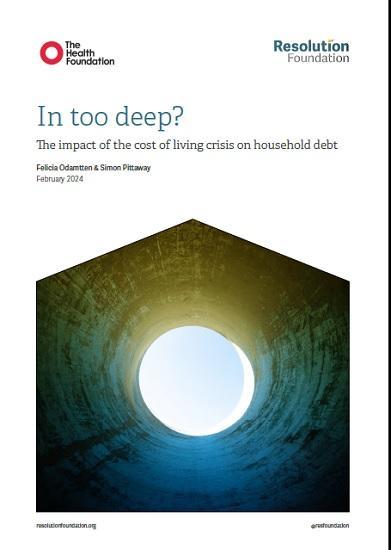In Too Deep? The Impact Of The Cost Of Living Crisis On Household Debt
29th February 2024

Economists Felicia Odamtten and Simon Pittaway from The Resolution Foundation look at household debt.
Hard economic times and rising interest rates have brought a renewed focus on household debt in recent years, with concerns that more and more families could find themselves overwhelmed by the burden of debt. So this briefing note takes a closer look at the use of consumer debt (such as credit cards, personal loans and overdrafts) through the pandemic and cost of living crisis.
We find that there is certainly some good news: despite the financial pressures of the past few years, British families today have less consumer debt relative to their incomes than at any point since records began. That means, despite rising rates, households are now spending a smaller share of income on consumer-debt repayments than before the pandemic.
However, partly in response to restricted access to consumer debt, there has been a rise in the number of households falling behind on priority bills like gas and electricity. This highlights the pressing need to boost saving and help families build up the financial resources they can draw down on in tough economic times.
The ratio of consumer debt to household income has fallen throughout the pandemic and cost of living crisis, leaving British families with the lowest level of consumer debt relative to their incomes since records began in 1999. Had the UK's debt-to-income ratio remained at its pre-pandemic level, our stock of consumer debt today would be £48 billion higher, or around £1,700 per household.
Survey evidence suggests that the share of households using consumer debt hasn't changed in recent years. Instead, average outstanding debts among those using consumer credit have fallen - particularly for poorer households.
Lower levels of debt mean that, even after the recent rise in interest rates, British families overall are spending a smaller share of their income servicing their consumer debt than they were before the pandemic. The lower share of income spent today represents a saving of £1.8 billion on UK's annual consumer debt interest bill versus pre-pandemic levels.
Part of the reason consumer debt has not risen recently is that lenders have made it harder to access credit. According to the Bank of England's Credit Conditions Survey, lenders have tightened their risk appetite for unsecured lending every quarter since mid-2022. Tighter credit conditions are more likely to bite for poorer households: with around one-in-eight (13 per cent) of the poorest fifth of families having been rejected for credit in the previous 12 months.
Faced with restricted access to consumer debt, many families have fallen behind on priority bills like gas and electricity to make ends meet. Ofgem data indicates that the number of accounts behind on their gas and electricity bills has reached the highest level since records began in 2012, and the latest data shows that average amount owed by those in arrears have increased by 51 per cent in a little over a year (between Q2 2022 and Q3 2023).
Going into debt on priority bills comes with high stakes, and there is a strong association between priority debt and negative health outcomes. For instance, someone is around twice as likely to report feeling ‘under strain’ if they owe money on priority bills, compared to someone who doesn’t.
Read the full Resolution Foundation report HERE
